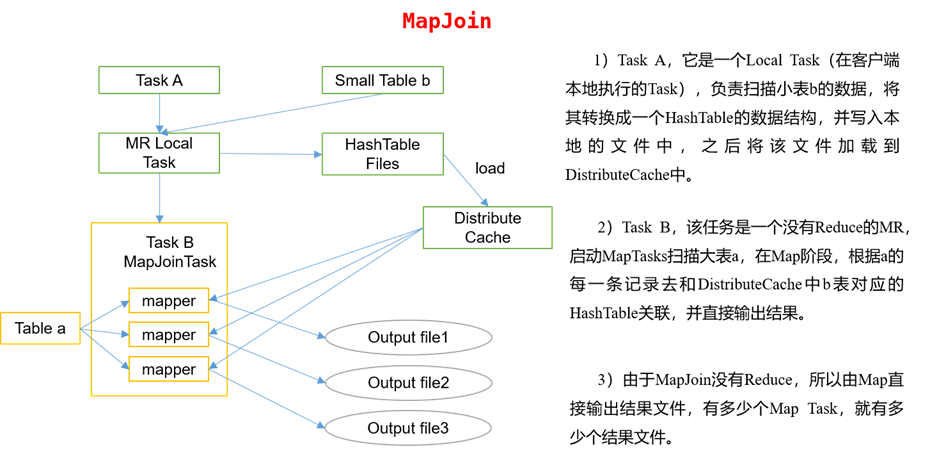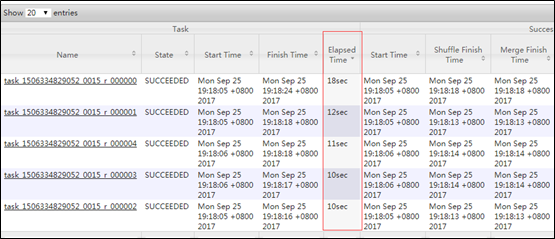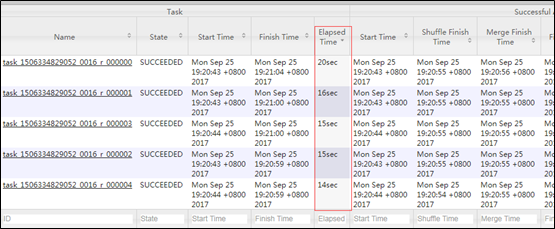Hive详解(06) - Hive调优实战
Hive详解(06) - Hive调优实战
执行计划(Explain)
基本语法
EXPLAIN [EXTENDED | DEPENDENCY | AUTHORIZATION] query
案例实操
(1)查看下面这条语句的执行计划
没有生成MR任务的
hive (default)> explain select * from emp;
Explain
STAGE DEPENDENCIES:
Stage-0 is a root stage
STAGE PLANS:
Stage: Stage-0
Fetch Operator
limit: -1
Processor Tree:
TableScan
alias: emp
Statistics: Num rows: 1 Data size: 7020 Basic stats: COMPLETE Column stats: NONE
Select Operator
expressions: empno (type: int), ename (type: string), job (type: string), mgr (type: int), hiredate (type: string), sal (type: double), comm (type: double), deptno (type: int)
outputColumnNames: _col0, _col1, _col2, _col3, _col4, _col5, _col6, _col7
Statistics: Num rows: 1 Data size: 7020 Basic stats: COMPLETE Column stats: NONE
ListSink
有生成MR任务的
hive (default)> explain select deptno, avg(sal) avg_sal from emp group by deptno;
Explain
STAGE DEPENDENCIES:
Stage-1 is a root stage
Stage-0 depends on stages: Stage-1
STAGE PLANS:
Stage: Stage-1
Map Reduce
Map Operator Tree:
TableScan
alias: emp
Statistics: Num rows: 1 Data size: 7020 Basic stats: COMPLETE Column stats: NONE
Select Operator
expressions: sal (type: double), deptno (type: int)
outputColumnNames: sal, deptno
Statistics: Num rows: 1 Data size: 7020 Basic stats: COMPLETE Column stats: NONE
Group By Operator
aggregations: sum(sal), count(sal)
keys: deptno (type: int)
mode: hash
outputColumnNames: _col0, _col1, _col2
Statistics: Num rows: 1 Data size: 7020 Basic stats: COMPLETE Column stats: NONE
Reduce Output Operator
key expressions: _col0 (type: int)
sort order: +
Map-reduce partition columns: _col0 (type: int)
Statistics: Num rows: 1 Data size: 7020 Basic stats: COMPLETE Column stats: NONE
value expressions: _col1 (type: double), _col2 (type: bigint)
Execution mode: vectorized
Reduce Operator Tree:
Group By Operator
aggregations: sum(VALUE._col0), count(VALUE._col1)
keys: KEY._col0 (type: int)
mode: mergepartial
outputColumnNames: _col0, _col1, _col2
Statistics: Num rows: 1 Data size: 7020 Basic stats: COMPLETE Column stats: NONE
Select Operator
expressions: _col0 (type: int), (_col1 / _col2) (type: double)
outputColumnNames: _col0, _col1
Statistics: Num rows: 1 Data size: 7020 Basic stats: COMPLETE Column stats: NONE
File Output Operator
compressed: false
Statistics: Num rows: 1 Data size: 7020 Basic stats: COMPLETE Column stats: NONE
table:
input format: org.apache.hadoop.mapred.SequenceFileInputFormat
output format: org.apache.hadoop.hive.ql.io.HiveSequenceFileOutputFormat
serde: org.apache.hadoop.hive.serde2.lazy.LazySimpleSerDe
Stage: Stage-0
Fetch Operator
limit: -1
Processor Tree:
ListSink
查看详细执行计划
hive (default)> explain extended select * from emp;
hive (default)> explain extended select deptno, avg(sal) avg_sal from emp group by deptno;
Fetch抓取
Fetch抓取是指,Hive中对某些情况的查询可以不必使用MapReduce计算。例如:SELECT * FROM employees;在这种情况下,Hive可以简单地读取employee对应的存储目录下的文件,然后输出查询结果到控制台。
在hive-default.xml.template文件中hive.fetch.task.conversion默认是more,老版本hive默认是minimal,该属性修改为more以后,在全局查找、字段查找、limit查找等都不走mapreduce。
<property>
<name>hive.fetch.task.conversion</name>
<value>more</value>
<description>
Expects one of [none, minimal, more].
Some select queries can be converted to single FETCH task minimizing latency.
Currently the query should be single sourced not having any subquery and should not have any aggregations or distincts (which incurs RS), lateral views and joins.
0. none : disable hive.fetch.task.conversion
1. minimal : SELECT STAR, FILTER on partition columns, LIMIT only
2. more : SELECT, FILTER, LIMIT only (support TABLESAMPLE and virtual columns)
</description>
</property>
1)案例实操:
(1)把hive.fetch.task.conversion设置成none,然后执行查询语句,都会执行mapreduce程序。
hive (default)> set hive.fetch.task.conversion=none;
hive (default)> select * from emp;
hive (default)> select ename from emp;
hive (default)> select ename from emp limit 3;
(2)把hive.fetch.task.conversion设置成more,然后执行查询语句,如下查询方式都不会执行mapreduce程序。
hive (default)> set hive.fetch.task.conversion=more;
hive (default)> select * from emp;
hive (default)> select ename from emp;
hive (default)> select ename from emp limit 3;
本地模式
大多数的Hadoop Job是需要Hadoop提供的完整的可扩展性来处理大数据集的。不过,有时Hive的输入数据量是非常小的。在这种情况下,为查询触发执行任务消耗的时间可能会比实际job的执行时间要多的多。对于大多数这种情况,Hive可以通过本地模式在单台机器上处理所有的任务。对于小数据集,执行时间可以明显被缩短。
用户可以通过设置hive.exec.mode.local.auto的值为true,来让Hive在适当的时候自动启动这个优化。
set hive.exec.mode.local.auto=true; //开启本地mr
//设置local mr的最大输入数据量,当输入数据量小于这个值时采用local mr的方式,默认为134217728,即128M
set hive.exec.mode.local.auto.inputbytes.max=50000000;
//设置local mr的最大输入文件个数,当输入文件个数小于这个值时采用local mr的方式,默认为4
set hive.exec.mode.local.auto.input.files.max=10;
1)案例实操:
(1)开启本地模式,并执行查询语句
hive (default)> set hive.exec.mode.local.auto=true;
hive (default)> select * from emp cluster by deptno;
Time taken: 1.328 seconds, Fetched: 14 row(s)
(2)关闭本地模式,并执行查询语句
hive (default)> set hive.exec.mode.local.auto=false;
hive (default)> select * from emp cluster by deptno;
Time taken: 20.09 seconds, Fetched: 14 row(s)
表的优化
小表大表Join(MapJoin)
将key相对分散,并且数据量小的表放在join的左边,这样可以有效减少内存溢出错误发生的几率;再进一步,可以使用map join让小的维度表(1000条以下的记录条数)先进内存。在map端完成join。
实际测试发现:新版的hive已经对小表JOIN大表和大表JOIN小表进行了优化。小表放在左边和右边已经没有明显区别。
案例实操
1)需求
测试大表JOIN小表和小表JOIN大表的效率
2)开启MapJoin参数设置
(1)设置自动选择Mapjoin
set hive.auto.convert.join = true; 默认为true
(2)大表小表的阈值设置(默认25M以下认为是小表):
set hive.mapjoin.smalltable.filesize = 25000000;
3)MapJoin工作机制

4)建大表、小表和JOIN后表的语句
// 创建大表
create table bigtable(id bigint, t bigint, uid string, keyword string, url_rank int, click_num int, click_url string) row format delimited fields terminated by '\t';
// 创建小表
create table smalltable(id bigint, t bigint, uid string, keyword string, url_rank int, click_num int, click_url string) row format delimited fields terminated by '\t';
// 创建join后表的语句
create table jointable(id bigint, t bigint, uid string, keyword string, url_rank int, click_num int, click_url string) row format delimited fields terminated by '\t';
5)分别向大表和小表中导入数据
hive (default)> load data local inpath '/opt/module/hive/datas/bigtable' into table bigtable;
hive (default)>load data local inpath '/opt/module/hive/datas/smalltable' into table smalltable;
6)小表JOIN大表语句
insert overwrite table jointable
select b.id, b.t, b.uid, b.keyword, b.url_rank, b.click_num, b.click_url
from smalltable s
join bigtable b
on b.id = s.id;
Time taken: 35.921 seconds
No rows affected (44.456 seconds)
7)执行大表JOIN小表语句
insert overwrite table jointable
select b.id, b.t, b.uid, b.keyword, b.url_rank, b.click_num, b.click_url
from bigtable b
join smalltable s
on s.id = b.id;
Time taken: 34.196 seconds
No rows affected (26.287 seconds)
大表Join大表
1)空KEY过滤
有时join超时是因为某些key对应的数据太多,而相同key对应的数据都会发送到相同的reducer上,从而导致内存不够。此时应该仔细分析这些异常的key,很多情况下,这些key对应的数据是异常数据,需要在SQL语句中进行过滤。例如key对应的字段为空,操作如下:
案例实操
(1)配置历史服务器
配置mapred-site.xml
<property>
<name>mapreduce.jobhistory.address</name>
<value>hadoop102:10020</value>
</property>
<property>
<name>mapreduce.jobhistory.webapp.address</name>
<value>hadoop102:19888</value>
</property>
启动历史服务器
sbin/mr-jobhistory-daemon.sh start historyserver
查看jobhistory
http://hadoop102:19888/jobhistory
(2)创建原始数据表、空id表、合并后数据表
// 创建空id表
create table nullidtable(id bigint, t bigint, uid string, keyword string, url_rank int, click_num int, click_url string) row format delimited fields terminated by '\t';
(3)分别加载原始数据和空id数据到对应表中
hive (default)> load data local inpath '/opt/module/hive/datas/nullid' into table nullidtable;
(4)测试不过滤空id
hive (default)> insert overwrite table jointable select n.* from nullidtable n
left join bigtable o on n.id = o.id;
(5)测试过滤空id
hive (default)> insert overwrite table jointable select n.* from (select * from nullidtable where id is not null ) n left join bigtable o on n.id = o.id;
2)空key转换
有时虽然某个key为空对应的数据很多,但是相应的数据不是异常数据,必须要包含在join的结果中,此时可以表a中key为空的字段赋一个随机的值,使得数据随机均匀地分不到不同的reducer上。例如:
案例实操:
不随机分布空null值:
(1)设置5个reduce个数
set mapreduce.job.reduces = 5;
(2)JOIN两张表
insert overwrite table jointable
select n.* from nullidtable n left join bigtable b on n.id = b.id;
结果:如下图所示,可以看出来,出现了数据倾斜,某些reducer的资源消耗远大于其他reducer。

set mapreduce.job.reduces = 5;
insert overwrite table jointable
select n.* from nullidtable n full join bigtable o on
结果:如下图所示,可以看出来,消除了数据倾斜,负载均衡reducer的资源消耗

row format delimited fields terminated by '\t';
load data local inpath '/opt/module/data/bigtable' into table bigtable2;
insert overwrite table jointable
select b.id, b.t, b.uid, b.keyword, b.url_rank, b.click_num, b.click_url
row format delimited fields terminated by '\t';
insert into bigtable_buck1 select * from bigtable;
row format delimited fields terminated by '\t';
insert into bigtable_buck2 select * from bigtable;
set hive.optimize.bucketmapjoin = true;
set hive.optimize.bucketmapjoin.sortedmerge = true;
set hive.input.format=org.apache.hadoop.hive.ql.io.BucketizedHiveInputFormat;
insert overwrite table jointable
select b.id, b.t, b.uid, b.keyword, b.url_rank, b.click_num, b.click_url
Group By
默认情况下,Map阶段同一Key数据分发给一个reduce,当一个key数据过大时就倾斜了。

并不是所有的聚合操作都需要在Reduce端完成,很多聚合操作都可以先在Map端进行部分聚合,最后在Reduce端得出最终结果。
set hive.groupby.mapaggr.checkinterval = 100000
set hive.groupby.skewindata = true
hive (default)> select deptno from emp group by deptno;
Stage-Stage-1: Map: 1 Reduce: 5 Cumulative CPU: 23.68 sec HDFS Read: 19987 HDFS Write: 9 SUCCESS
Total MapReduce CPU Time Spent: 23 seconds 680 msec
hive (default)> set hive.groupby.skewindata = true;
hive (default)> select deptno from emp group by deptno;
Stage-Stage-1: Map: 1 Reduce: 5 Cumulative CPU: 28.53 sec HDFS Read: 18209 HDFS Write: 534 SUCCESS
Stage-Stage-2: Map: 1 Reduce: 5 Cumulative CPU: 38.32 sec HDFS Read: 15014 HDFS Write: 9 SUCCESS
Total MapReduce CPU Time Spent: 1 minutes 6 seconds 850 msec
Count(Distinct) 去重统计
hive (default)> create table bigtable(id bigint, time bigint, uid string, keyword
string, url_rank int, click_num int, click_url string) row format delimited
hive (default)> load data local inpath '/opt/module/datas/bigtable' into table bigtable;
set mapreduce.job.reduces = 5;
hive (default)> select count(distinct id) from bigtable;
Stage-Stage-1: Map: 1 Reduce: 1 Cumulative CPU: 7.12 sec HDFS Read: 120741990 HDFS Write: 7 SUCCESS
Total MapReduce CPU Time Spent: 7 seconds 120 msec
Time taken: 23.607 seconds, Fetched: 1 row(s)
hive (default)> select count(id) from (select id from bigtable group by id) a;
Stage-Stage-2: Map: 1 Reduce: 1 Cumulative CPU: 4.29 sec2 HDFS Read: 9409 HDFS Write: 7 SUCCESS
Total MapReduce CPU Time Spent: 21 seconds 820 msec
Time taken: 50.795 seconds, Fetched: 1 row(s)
虽然会多用一个Job来完成,但在数据量大的情况下,这个绝对是值得的。
笛卡尔积
尽量避免笛卡尔积,join的时候不加on条件,或者无效的on条件,Hive只能使用1个reducer来完成笛卡尔积。
行列过滤
列处理:在SELECT中,只拿需要的列,如果有分区,尽量使用分区过滤,少用SELECT *。
行处理:在分区剪裁中,当使用外关联时,如果将副表的过滤条件写在Where后面,那么就会先全表关联,之后再过滤,比如:
hive (default)> select o.id from bigtable b
Time taken: 34.406 seconds, Fetched: 100 row(s)
hive (default)> select b.id from bigtable b
join (select id from bigtable where id <= 10 ) o on b.id = o.id;
Time taken: 30.058 seconds, Fetched: 100 row(s)
使用分区表
详见《Hive详解(03) - hive SQL基础使用》分区表和分桶表章节
使用分桶表
详见《Hive详解(03) - hive SQL基础使用》分区表和分桶表章节
合理设置Map及Reduce数
1)通常情况下,作业会通过input的目录产生一个或者多个map任务。
主要的决定因素有:input的文件总个数,input的文件大小,集群设置的文件块大小。
3)是不是保证每个map处理接近128m的文件块,就高枕无忧了?
答案也是不一定。比如有一个127m的文件,正常会用一个map去完成,但这个文件只有一个或者两个小字段,却有几千万的记录,如果map处理的逻辑比较复杂,用一个map任务去做,肯定也比较耗时。
针对上面的问题2和3,我们需要采取两种方式来解决:即减少map数和增加map数;
复杂文件增加Map数
当input的文件都很大,任务逻辑复杂,map执行非常慢的时候,可以考虑增加Map数,来使得每个map处理的数据量减少,从而提高任务的执行效率。
hive (default)> select count(*) from emp;
Hadoop job information for Stage-1: number of mappers: 1; number of reducers: 1
hive (default)> set mapreduce.input.fileinputformat.split.maxsize=100;
hive (default)> select count(*) from emp;
Hadoop job information for Stage-1: number of mappers: 6; number of reducers: 1
小文件进行合并
1)在map执行前合并小文件,减少map数:CombineHiveInputFormat具有对小文件进行合并的功能(系统默认的格式)。HiveInputFormat没有对小文件合并功能。
set hive.input.format= org.apache.hadoop.hive.ql.io.CombineHiveInputFormat;
SET hive.merge.mapfiles = true;
SET hive.merge.mapredfiles = true;
SET hive.merge.size.per.task = 268435456;
当输出文件的平均大小小于该值时,启动一个独立的map-reduce任务进行文件merge
SET hive.merge.smallfiles.avgsize = 16777216;
合理设置Reduce数
hive.exec.reducers.bytes.per.reducer=256000000
在hadoop的mapred-default.xml文件中修改
set mapreduce.job.reduces = 15;
(2)另外,有多少个reduce,就会有多少个输出文件,如果生成了很多个小文件,那么如果这些小文件作为下一个任务的输入,则也会出现小文件过多的问题;
在设置reduce个数的时候也需要考虑这两个原则:处理大数据量利用合适的reduce数;使单个reduce任务处理数据量大小要合适;
并行执行
通过设置参数hive.exec.parallel值为true,就可以开启并发执行。不过,在共享集群中,需要注意下,如果job中并行阶段增多,那么集群利用率就会增加。
set hive.exec.parallel=true; //打开任务并行执行
set hive.exec.parallel.thread.number=16; //同一个sql允许最大并行度,默认为8。
当然,得是在系统资源比较空闲的时候才有优势,否则,没资源,并行也起不来。
严格模式
JVM重用
详见《Hadoop详解(08) - Hadoop企业优化方案》Hadoop小文件优化方法中的JVM重用
压缩
Hive详解(06) - Hive调优实战的更多相关文章
- Spark详解(09) - Spark调优
Spark详解(09) - Spark调优 Spark 性能调优 常规性能调优 常规性能调优一:最优资源配置 Spark性能调优的第一步,就是为任务分配更多的资源,在一定范围内,增加资源的分配与性能的 ...
- Hive详解(04) - hive函数的使用
Hive详解(04) - hive函数的使用 系统内置函数 查看系统自带的函数 hive> show functions; 显示自带的函数的用法 hive> desc function u ...
- Hive详解(03) - hive基础使用
Hive详解(03) - hive基础使用 Hive数据类型 基本数据类型 对于Hive的String类型相当于数据库的varchar类型,该类型是一个可变的字符串,不过它不能声明其中最多能存储多少个 ...
- Hive详解(02) - Hive 3.1.2安装
Hive详解(02) - Hive 3.1.2安装 安装准备 Hive下载地址 Hive官网地址:http://hive.apache.org/ 官方文档查看地址:https://cwiki.apac ...
- JVM内存参数详解以及配置调优
基本概念:PermGen space:全称是Permanent Generation space.就是说是永久保存的区域,用于存放Class和Meta信息,Class在被Load的时候被放入该区域He ...
- Hive详解(01) - 概念
Hive详解(01) - 概念 hive简介 Hive:由Facebook开源用于解决海量结构化日志的数据统计工具,是基于Hadoop的一个数据仓库工具,可以将结构化的数据文件映射为一张表,并提供类S ...
- Hive 的简单使用及调优参考文档
Hive 的简单使用及调优参考文档 HIVE的使用 命令行界面 使用一下命令查看hive的命令行页面, hive --help --service cli 简化命令为hive –h 会输出下面的这 ...
- Hive详解(05) - 压缩和存储
Hive详解(05) - 压缩和存储 Hadoop压缩配置 MR支持的压缩编码 压缩格式 算法 文件扩展名 是否可切分 DEFLATE DEFLATE .deflate 否 Gzip DEFLATE ...
- 高性能 Java 计算服务的性能调优实战
作者:vivo 互联网服务器团队- Chen Dongxing.Li Haoxuan.Chen Jinxia 随着业务的日渐复杂,性能优化俨然成为了每一位技术人的必修课.性能优化从何着手?如何从问题表 ...
随机推荐
- Java中的反射与代理(2)
在经典的GoF设计模式中,有一种模式叫做代理模式,好比以前洋务运动的时候所说的「买办」,还有现在咱们经常听到的「代理人」战争中的「代理」,都是同一个意思--代替某人打理. 例如,很多北漂都找中介或者二 ...
- Linux、Windows下Redis的安装即Redis的基本使用详解
前言 什么是Redis Redis是一个基于内存的key-value结构数据库.Redis 是互联网技术领域使用最为广泛的存储中间件,它是「Remote Dictionary Service」的首字母 ...
- 如何在IDEA中自定义模板、快速生成完整的代码?
文章目录 1.修改现有的模板 2.自定义模板 3.在代码中测试自定义模板 1.修改现有的模板 打开设置面板- settings 2.自定义模板 选择定义模板组 选择创建模板 define 代表应用的范 ...
- 7.httpie
可以使用curl或httpie测试我们的服务器.Httpie是用Python编写的用户友好的http客户端 安装:pip3 install httpie #get请求示例 输入命令:http ht ...
- 【神经网络】丢弃法(dropout)
丢弃法是一种降低过拟合的方法,具体过程是在神经网络传播的过程中,随机"沉默"一些节点.这个行为让模型过度贴合训练集的难度更高. 添加丢弃层后,训练速度明显上升,在同样的轮数下测试集 ...
- nrf9160 做modem—— 连接云(接入方式MQTT)
今天测试把nrf9160作为modem的例程Serial LTE Modem程序(后面简称slm),何为做modem,通俗来说就是将nrf9160作为无线模块,主控由其余MCU做,主控通过AT命令控制 ...
- 在CentOS7下安装Oracle11教程
前言 安装oracle时,发现网上的文章总是缺少一些信息,导致安装不顺利,因为我对一些文章进行了整合,用以备忘. Oracle安装 首先下载linux版本的oracle安装文件,然后通过XFTP上传到 ...
- Python标准库之 xml.etree.ElementTree
Element类型是一种灵活的容器对象,用于在内存中存储结构化数据. 每个element对象都具有以下属性: 1. tag:string对象,表示数据代表的种类. 2. attrib:dictiona ...
- zk系列二:zookeeper实战之分布式统一配置获取
前面介绍了zk的一些基础知识,这篇文章主要介绍下如何在java环境下获取zk的配置信息:主要基于zk的监听器以及回调函数通过响应式编程的思想将核心代码糅合成一个工具类,几乎做到了拿来即用: 在分布式集 ...
- mysql是如何实现mvcc的
mvcc的概念 mvcc即多版本并发控制,是一种并发控制的策略,能让数据库在高并发下做到安全高效的读写,提升数据库的并发性能; 是一种用来解决并发下读写冲突的无锁解决方案,为事务分配单向增长时间戳,为 ...
